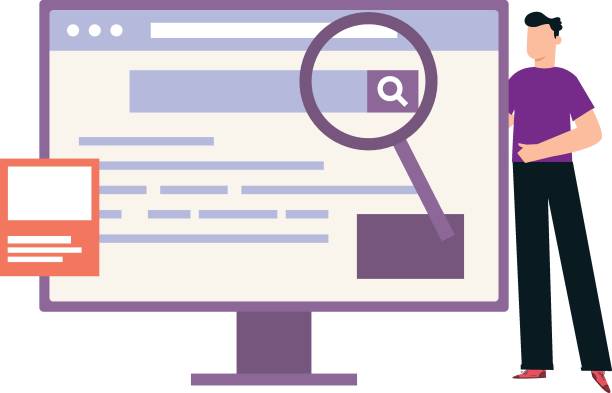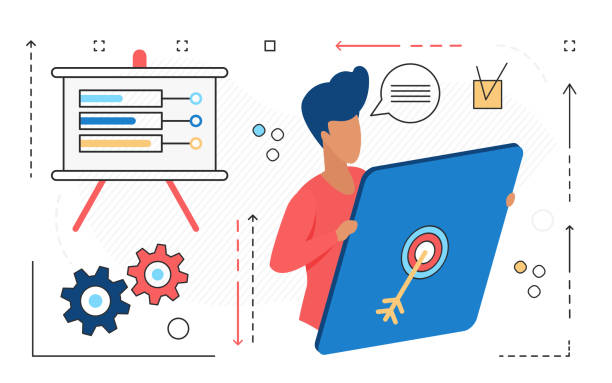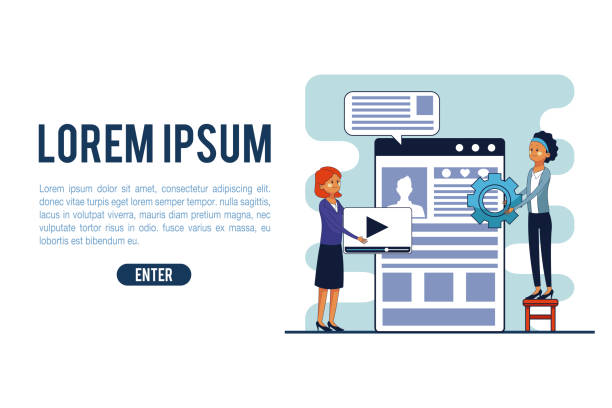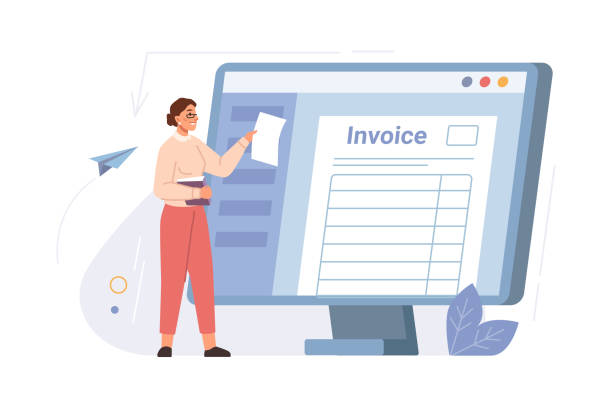Introduction to the Modern UI Website Design Revolution

In today’s digital world, where competition to attract users’ attention is more #intense than ever, simply having a website is not enough.
What distinguishes a website from others is its #User Interface (UI) and #User Experience (UX).
Modern UI website design not only means visual beauty, but also includes simplicity, functionality, and easy accessibility for all users.
This descriptive approach in web design ensures that visitors are not only attracted to your site, but also have an enjoyable experience that encourages them to return.
A modern user interface optimizes user interactions and smooths the path to their goal.
From entering the site to making a purchase or finding desired information, every step should be effortless and completely intuitive.
This is critically important for businesses, as it directly impacts conversion rates and customer satisfaction.
For example, websites that utilize the principles of modern UI website design typically have lower bounce rates and users spend more time on them.
Did you know that 85% of customers check your company’s website before any interaction?
Build a corporate website worthy of your credibility with RasaWeb.
✅ Increase credibility and customer trust
✅ Attract quality leads
⚡ Get free website design consultation
Key Principles in Modern User Interface Design
![]()
One of the most important aspects of modern UI website design is its focus on user-centric principles.
This means that every element and every interaction should be designed with users’ needs, behaviors, and expectations in mind.
This educational section will help you become familiar with the basic principles of this type of design.
The first principle is simplicity; a user interface should be free of any unnecessary complexity.
The fewer steps a user has to take to achieve their goal, the better their experience will be.
The second principle is consistency; visual and interactive elements throughout the site should follow a single design language so that the user does not feel confused.
Consistency in colors, fonts, and icon styles is of great importance. The third principle is visual feedback; the system should react to every user action, whether it’s changing the color of a button or displaying a success message.
The fourth principle is accessibility, which ensures the site is usable for people with different abilities, including those with disabilities.
This includes using appropriate contrast, alternative texts for images, and keyboard navigation.
Finally, flexibility, which means Responsive Design, displays the website correctly on any screen size, from mobile to desktop, providing a seamless experience.
Visual Elements in Modern Web Design

Visual elements play a vital role in the aesthetics and functionality of modern UI website design.
This specialized section delves into these elements in more detail.
Colors are the first thing that catches the user’s eye and can evoke specific emotions.
Choosing the right color palette should not only align with brand identity but also aid content readability.
For example, using high contrast between text and background for better readability is essential.
Typography, or the selection and arrangement of fonts, is also of particular importance.
Fonts must be legible and convey the designer’s intended emotions.
Using different fonts for headings and body text can create a visual hierarchy.
Images and icons also play a key role in conveying messages and adding visual appeal to the site.
High-quality images relevant to the content can increase user engagement.
Icons should be simple, recognizable, and consistent with the overall design style.
Whitespace is also a powerful visual element that gives content “breathing room” and prevents clutter.
This space allows the user’s eye to rest between different elements of the site and focus on the main content.
All these elements must be harmonized to provide a pleasant and user-friendly visual experience for a website with modern UI website design.
Below, a table of best practices for visual design in modern UI is presented:
| Visual Element | Importance in Modern UI | Example/Solution |
|---|---|---|
| Colors | Creating brand identity and feel, readability | Using a limited and consistent color palette, high contrast for text |
| Typography | Readability, visual hierarchy | Choosing legible fonts, using different sizes and weights for headings and body |
| Images and Icons | Visual appeal, quick message conveyance | Using high-quality and relevant images, simple and consistent icons |
| Whitespace | Increased readability, reduced clutter | Appropriate spacing between elements, grouping related content |
| Animations | Visual feedback, increased appeal | Subtle animations for buttons and forms, smooth transitions between pages |
Responsive Design: A Core Pillar of Modern Web Design

In the current era, where users access the internet from various devices, responsive design has become a necessity in modern UI website design.
This guide section elaborates on the importance and implementation of this approach.
Responsive design means that your website should automatically adjust itself to the screen size of the user’s device.
This includes resizing images, adjusting element layouts, and optimizing navigation for mobile, tablet, laptop, and desktop.
The main goal is for the user experience to be consistent and optimized regardless of the device used.
If your website does not display correctly on a smartphone, users will quickly leave it and go to your competitors.
This not only negatively impacts user experience but can also harm your site’s SEO ranking, as search engines like Google prioritize responsive websites.
To implement responsive design, CSS Media Queries are commonly used, which allow designers to apply different styles for different screen sizes.
Furthermore, adopting a Mobile-First approach, where design starts with mobile devices and then expands to larger screens, helps ensure an excellent experience across all devices.
Are you tired of losing business opportunities due to not having a professional corporate website?
RasaWeb, with its professional corporate website design, helps you:
✅ Build a powerful and credible brand image
✅ Convert website visitors into loyal customers
⚡ Click now to receive a free consultation!
Performance and Speed Optimization in Modern User Interface

Website loading speed is one of the critical factors for the success of a modern UI website design.
In this analytical section, we explore how to optimize website performance to deliver a seamless user experience.
Today’s users are impatient and expect websites to load in a fraction of a second.
Any delay, even a few hundred milliseconds, can lead to losing a user.
Image optimization, such as compression and using next-gen formats (like WebP), is one of the first steps.
Code minification (HTML, CSS, JavaScript) by removing extra spaces and unnecessary characters can also help reduce file sizes.
Caching, which allows the user’s browser to store static site files, significantly speeds up subsequent loads.
Using a Content Delivery Network (CDN) can also increase loading speed for users in different parts of the world, as content is delivered from the server closest to the user.
Furthermore, server-side optimization, such as using robust hosting and database optimization, also impacts the overall site speed.
All these measures not only improve the user experience but also affect the site’s ranking in search engines, as loading speed is an important factor in SEO algorithms.
Beyond Appearance: Interaction and User Experience (UX)

While modern UI website design addresses the look and feel of a website, User Experience (UX) refers to the totality of the user’s interaction with the site.
This explanatory section discusses the differences and overlaps between these two concepts.
UX encompasses all aspects of user interaction with a product; from the moment a user enters the site to the moment they leave it.
The goal of UX is to ensure that the user can easily, effectively, and with complete satisfaction pursue their goals on the site. This includes Information Architecture (IA), Interaction Design, User Journeys, and usability testing.
For example, good UX ensures that navigation menus are logical and predictable, forms are simple and completable, and information is easily found.
In fact, UI is only a part of UX.
A beautiful UI without strong UX is like a luxury car without a powerful engine – it looks good, but lacks the necessary functionality.
On the other hand, excellent UX can be negated by a poor UI, as the user may become discouraged from the site due to an inappropriate or unreadable appearance.
Therefore, success in modern UI website design requires a balance and harmony between these two concepts to provide a comprehensive and unparalleled experience for the user.
Emerging Trends in User Interface Design

The world of modern UI website design is constantly evolving, with new trends emerging daily.
This news section explores some of these emerging trends that are shaping the future of web design.
One of the most important trends is the use of Artificial Intelligence (AI) and Machine Learning (ML) for personalizing the user experience.
These technologies allow websites to adapt content and the user interface based on individual user behaviors and preferences, leading to incredibly unique experiences.
Voice User Interfaces (Voice UI) are also gaining popularity, given the growth of voice assistants like Siri and Alexa.
Designing websites for voice interactions presents a new and exciting challenge.
Micro-interactions, such as small animations when clicking a button or filling out a form, not only add appeal to the site but also provide subtle and useful feedback that improves the user experience.
Dark Mode has also become a standard feature in many modern websites due to visual comfort and reduced eye strain in low-light environments.
Additionally, Augmented Reality (AR) and Virtual Reality (VR) are slowly making their way into web experiences, creating new potentials for richer and more immersive interactions.
All these trends indicate the continuous evolution in modern UI website design, and designers must always stay up-to-date.
Below, a table of emerging trends and their applications in UI/UX design is presented:
| Emerging Trend | Description | Impact on UI/UX |
|---|---|---|
| Artificial Intelligence and Personalization | Adjusting content and user interface based on user behavior | Unique user experience, increased engagement and conversion rate |
| Voice User Interface (Voice UI) | Ability to interact with the website via voice commands | Increased accessibility, new navigation methods |
| Micro-interactions | Small animations and feedback for user actions | Increased appeal, user guidance, improved experience |
| Dark Mode | Dark mode for user interface | Reduced eye strain, battery saving on OLED, modern aesthetics |
| Augmented Reality (AR) and Virtual Reality (VR) | Integrating virtual elements with the real world or creating fully virtual environments | Richer and more immersive experiences, new applications in e-commerce and entertainment |
Tools and Technologies Used in Modern User Interface Design

To implement a modern UI website design, designers and developers need a set of tools and technologies.
This educational section introduces some of the most commonly used ones.
In the design and prototyping phase, tools such as Figma, Adobe XD, and Sketch are very popular.
These tools allow for UI design, creating wireframes, interactive prototypes, and team collaboration.
For frontend (client-side) development, the main languages are HTML for structure, CSS for styling, and JavaScript for adding interactivity and dynamism to the website.
CSS frameworks like Bootstrap and Tailwind CSS help speed up the responsive design process and create standard UI elements.
For JavaScript, frameworks such as React, Vue.js, and Angular enable the creation of complex and interactive user interfaces with high performance.
Additionally, Content Management Systems (CMS) like WordPress, with their diverse themes and plugins, enable modern UI website design even for non-specialists.
The choice of the right tool depends on the project’s needs and complexity, but familiarity with these technologies is essential for anyone working in modern web design.
Are you tired of losing business opportunities due to not having a professional corporate website?
RasaWeb, with its professional corporate website design, helps you:
✅ Build a powerful and credible brand image
✅ Convert website visitors into loyal customers
⚡ Get a free consultation now!
Challenges and Solutions for User-Friendly UI Design

Designing a modern and user-friendly interface is not always without challenges.
This thought-provoking section addresses some common problems and effective solutions to overcome them.
One of the main challenges is increased complexity due to too many features.
Designers may be tempted to add every possible feature to the site, which leads to clutter and user confusion.
The solution is to always focus on core user needs and avoid adding unnecessary features.
Another challenge is maintaining consistency and coherence in design for large projects, especially when different teams are working on different parts.
Using Design Systems, which include style guides, UI components, and design principles, can help maintain consistency.
Dealing with varying user expectations is also a challenge; what is intuitive for one user might be confusing for another.
Conducting Usability Testing with real users and gathering feedback is the best way to identify weaknesses and improve the experience.
Also, ensuring Accessibility for all users, including people with disabilities, is often overlooked but a crucial aspect of modern design.
These challenges require strategic thinking and a continuous approach to improvement for a modern UI website design to be truly user-friendly.
The Importance of Testing and Feedback in UI Enhancement

The process of modern UI website design is an iterative cycle that involves continuous testing and feedback collection.
This guide section addresses the critical importance of this phase.
Even the best designers cannot fully predict user experiences, which is why usability tests are essential.
Testing with real users allows you to identify weaknesses in navigation, confusing elements, or any issues that could disrupt the user experience.
These tests can be conducted in-person, remotely, or using specific tools (such as eye-tracking or heatmaps).
In addition to direct tests, collecting continuous feedback from users through surveys, contact forms, or even behavioral analysis using tools like Google Analytics, provides valuable insights.
This feedback helps you understand how users interact with your site, what sections they like, and what sections need improvement.
Based on this information, you can make the necessary changes to your modern UI website design and continuously enhance it.
This approach ensures that your site is always aligned with user needs and expectations and provides a better user experience, ultimately leading to your business success.
Frequently Asked Questions
| Row | Question | Answer |
|---|---|---|
| 1 | What does Modern User Interface (Modern UI) mean in website design? | Modern UI refers to designing websites with a minimalist appearance, extensive use of whitespace, clear typography, vibrant colors or unified palettes, subtle animations, and a focus on visual and intuitive User Experience (UX). |
| 2 | What features make a user interface “modern”? | Key features include responsive design, smooth animations, use of vectors and SVG icons, prominent typography, ample whitespace, creative layering, appropriate colors, and a focus on accessibility. |
| 3 | What is the importance of Responsive Design in modern UI? | Responsive design ensures that the website displays correctly on any device (mobile, tablet, desktop) and provides a consistent user experience, which is a fundamental principle of modern UI. |
| 4 | Why is the use of Whitespace important in modern design? | Whitespace or “negative space” helps text and other elements breathe and be distinguishable, increases readability, enhances user focus on the main content, and creates a clean and professional appearance. |
| 5 | What is the role of animations and micro-interactions in modern UI? | Animations and micro-interactions (small interactions) make the user experience more dynamic and engaging, provide feedback to the user, improve navigation flow, and add a sense of quality and polish to the design. |
| 6 | What is the place of typography in modern website design? | Typography plays a very important role in modern design; appropriate fonts, size, weight, and correct spacing improve readability and can convey a specific mood and personality to the brand. |
| 7 | How can visual consistency be achieved in modern design? | By using a Design System, a limited and specific color palette, consistent typography, reusable UI components, and maintaining uniformity in spacing between elements and visual rhythm. |
| 8 | What is the relationship between User Experience (UX) and modern User Interface (UI)? | User Interface (UI) is the visual and interactive part of a product, while User Experience (UX) relates to the overall feeling of the user when using the product. A modern UI should help improve UX and be functional and intuitive beyond visual beauty. |
| 9 | What are some common trends in modern UI design? | Trends include Dark Mode, Neumorphism, Glassmorphism, large and prominent typography, use of gradients, 3D images, and Lottie animations. |
| 10 | What are the main challenges in modern UI website design? | Challenges include maintaining simplicity while innovating, ensuring Accessibility, optimizing loading speed despite heavy animations and images, and maintaining a balance between aesthetics and functionality. |
And other advertising services of RasaWeb advertising agency
Smart Content Strategy: Designed for businesses seeking campaign management through engaging UI design.
Smart Marketplace: An effective tool for customer attraction with the help of marketing automation.
Smart SEO: An effective tool for increasing sales with the help of real data.
Smart Marketing Automation: An innovative service for increasing click-through rates through engaging UI design.
Smart Custom Software: Transform online growth by optimizing key pages.
And over a hundred other services in the field of internet advertising, advertising consulting, and organizational solutions.
Internet Advertising | Advertising Strategy | Advertorial
Revolutionize your business in the online world with RasaWeb Afarin Digital Marketing Agency; from fast website design to comprehensive SEO strategies.
📍 Tehran, Mirdamad Street, next to Bank Markazi, Kazeroon Janoubi Alley, Ramin Alley, No. 6




